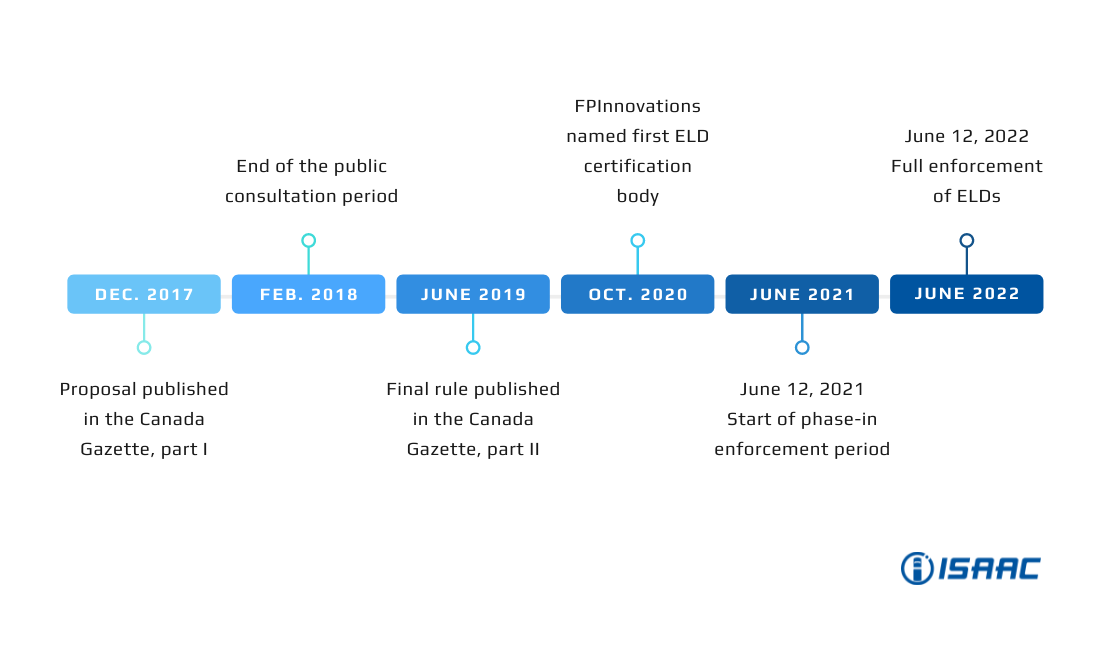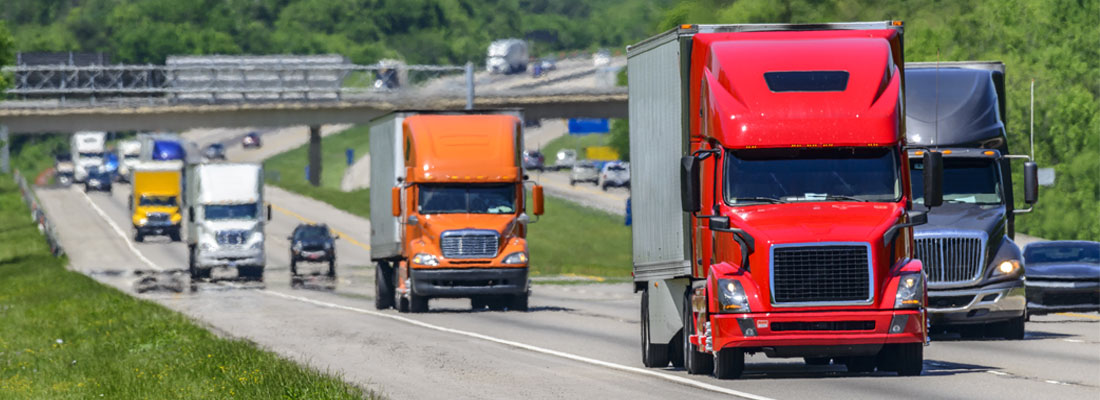What is an ELD?
An ELD is a tamper-resistant device synced with a vehicle’s engine that electronically records the operation dates and times of a commercial vehicle. It allows you to know when and for how long a vehicle is travelling to ensure that drivers respect their daily limit and accurately log their working hours.
Why make the use of ELDs mandatory?
According to Transport Canada, the regulation will improve road safety for all road users. Knowing that driver fatigue is still an issue, the mandatory use of ELDs could reduce the risk of fatigue-related collisions by approximately 10%. The Saskatchewan Coroners Service had also recommended the use of ELDs following the collision involving the Humboldt Broncos junior hockey team in April 2018.
In addition to improving security, ELDs will save carriers time and money due to the administrative burden of paper logs. They will help carriers comply with the Hours of Service Regulations and reduce the impacts of non-compliance.
The objective of using ELDs is also to promote and ensure fair competition for Canadian carriers. Tamper-proof devices will require everyone to follow regulations in the same way.
Who must comply?
The new rules apply to federally regulated carriers, which means nearly 157,500 commercial vehicle drivers. In Canada, a company that provides extra-provincial transportation, including its local activities, falls under federal jurisdiction, while a company operating within a province falls under provincial jurisdiction.
For the time being, no changes apply to provincially regulated carriers. Each province will need to adopt the rules based on its specific provincial reality.
Main exemptions
- short-term rentals, i.e., less than 30 days
- commercial vehicles built before the year 2000
- vehicles operated within a 160 km radius from their home terminal, which are not currently required to keep logbooks
- vehicles operated by a motor carrier to which an exemption has been issued by provincial or federal authorities
What is the effective date?
The federal rule will come into effect on June 12, 2021. However, the Minister of Transport announced in April 2021 that full implementation of the rule by the provinces and territories would not begin in June 2021 as planned. The federal department will work with the provinces to develop a phase-in enforcement plan, which will extend to no later than June 2022. In the meantime, providers must have their ELD tested and certified by an accredited certification body. A list of certified devices will be available and updated on the Transport Canada website. The list can be used by motor carriers to identify certified ELDs and by roadside inspection authorities for verification purposes.

Similarities: United States and Canada
Canadian requirements have been aligned with those of the United States to facilitate operations. This will allow carriers to use a single ELD solution in both countries, ensuring that the chosen ELD is approved on both sides of the border.
Among the similarities, here are the main elements that must be well understood by users:
- Automatic detection of driving status from 8 km/h. When the vehicle is travelling at a speed of 8 km/h or more, the log should automatically display the “driving” status.
- Automatic return to “on duty” status after a 6-minute stop. After a 5-minute stop, a message must appear on the ELD screen asking the driver if they wish to change their duty status. If the driver does not respond within one minute, the status changes automatically to “on duty” and the elapsed 6 minutes will be registered as driving.
- “Yard move” feature. Since the ELD indicates the driving status as soon as the vehicle exceeds a speed of 8 km/h, a driver travelling in a customer’s yard can activate the “yard move” mode in order to remain in the “on duty” status, if yard move is authorized by the carrier.
- Diagnostics and defect management. A diagnostic is a minor problem while a defect signals a major problem. The ELD must, for example, automatically detect an odometer jump, disconnection from the device, etc.
- Unassigned driving management. When a driver registers in a vehicle, the ELD shows the unassigned driving times that need attention. They must accept or reject them.
- Change approval by drivers. Drivers will need to approve any changes before they are applied to their logbook.
- No modification of automatically recorded driving. A driving segment automatically recorded when the vehicle exceeds 8 km/h cannot be shortened. In case of a problem, the driver can annotate the driving segment to explain the situation. The driver can also change other statuses as needed.
Differences: United States and Canada
The two ELD regulations differ. For carriers operating in both countries, it is important to be aware of these distinctions in order to properly train users and avoid errors.
Certification process
In the United States, ELD providers perform self-certification in order to be registered on the FMCSA list (Federal Motor Carrier Safety Administration). To date, there are nearly 500 devices on this list. To find a supplier, carriers must conduct their search, keeping in mind that their compliance depends on their choice of ELD supplier.
To ensure a higher level of compliance, the Government of Canada has opted for a third-party certification process. This way, ELD providers must pay to have their solution tested and certified by an accredited body. The objective of this approach is to protect carriers by ensuring that an independent authority has validated that ELDs comply with technical requirements and cannot be falsified. There is currently only one accredited certification body: FPInnovations of Pointe-Claire, Quebec.
Use during malfunction
In the event of device failure, the driver’s hours of service can be recorded with an alternate method (usually paper log) for a maximum of 8 days in the U.S. In Canada, the driver may use paper daily logs for a maximum of 14 days or until his return to the home terminal from the current trip, if the trip lasts longer than 14 days. After this period, the ELD must be repaired or replaced and fully functional.
Notification prior to violations
Unlike the U.S. regulations, the Canadian version requires the ELD to notify the driver at least 30 minutes prior to reaching any limit imposed by the current hours of service rules. This is to keep the driver informed and thus avoid violations for the driver and ensure road safety.
Supporting Canadian rules
In Canada, the hours of service rules have more situations and provisions than the U.S. rules. A Canadian ELD must support all of them. Here are the main situations:
– 2 cycles: Cycle 1 (70 hours over 7 days) and Cycle 2 (120 hours over 14 days)
– 2 zones of operation: South of 60th and North of 60th
– Deferral of daily Off-duty time to the following day (day 1 / day 2)
Choosing a partner
If you are subject to the Canadian regulations, consider choosing an ELD provider who will also act as a partner. A solution like ISAAC’s will not only enable your fleet to be compliant in both Canada and the United States but will also optimize your overall operations. Your assigned project manager can help and guide you through the implementation process.
*Last update: May 13, 2021

